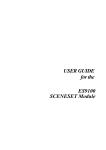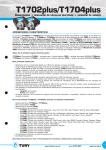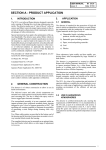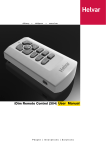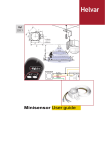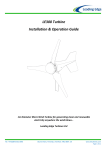Download USER GUIDE for the HES92060 SINEWAVE DIMMER Module
Transcript
USER GUIDE for the HES92060 SINEWAVE DIMMER Module HES92060 User Guide for the Imagine HES92060 SINEWAVE DIMMER Module Document 7860088 Issue 1 (27/02/03) Copyright © 2002 Helvar Merca Ltd. All rights reserved. No part of this documentation may be reproduced or transmitted in any form or by any means, electronic or mechanical, including photocopying and recording, without the prior written permission of Helvar Merca Ltd. The information in this documentation is supplied without warranty of any kind, either directly or indirectly, and is subject to change without prior written notice. Helvar Merca Ltd., its employees or appointed representatives will not be held responsible for any damages to software, hardware, or data, howsoever arising as a direct or indirect result of the product(s) mentioned herein. Issued by: Helvar Merca Ltd., Hawley Mill, Hawley Road, Dartford, Kent, DA2 7SY, United Kingdom. www.helvar.co.uk Printed in the United Kingdom. PREFACE PREFACE Scope of this User Guide The descriptions and instructions contained in this guide are based on the assumption that the DIMMER module is being installed and used as part of a Helvar Merca Ltd. Imagine Lighting System. The installation instructions refer to the DIMMER module being installed in a STACKER unit. Technical Specifications Any technical data required for the correct installation and use of the DIMMER module is contained in this user guide. Firmware Version The operational instructions contained in this user guide assume that the DIMMER module is using the following firmware version: HES92060 version 1.0 firmware. The dimmer module briefly reports the firmware version during power-up test. Refer to section 2, page 10 for further details. Trade Marks IMAGINE™, SCENESET™, SCENEMAKER™, SCENETIMER™, SCENE PLANNER™, SCENESOFT™, and SCENE COMMANDER™ are trade marks of Helvar. 7860088 issue 1 iii HES92060 USER GUIDE This page is intentionally left blank. iv 7860088 issue 1 CONTENTS CONTENTS SECTION 1 INTRODUCTION 1 GENERAL DESCRIPTION . . . . . . . . . . . . . . . . . . . . . . . . . . . . . . . . . . . . . . . . . . . 2 EXTERNAL LAYOUT . . . . . . . . . . . . . . . . . . . . . . . . . . . . . . . . . . . . . . . . . . . . . . . 3 Front Panel . . . . . . . . . . . . . . . . . . . . . . . . . . . . . . . . . . . . . . . . . . . . . . . . 3 Rear Panel. . . . . . . . . . . . . . . . . . . . . . . . . . . . . . . . . . . . . . . . . . . . . . . . . . 3 Right Side Panel . . . . . . . . . . . . . . . . . . . . . . . . . . . . . . . . . . . . . . . . . . . . 3 Left Side Panel . . . . . . . . . . . . . . . . . . . . . . . . . . . . . . . . . . . . . . . . . . . . . . 3 SECTION 2 INSTALLING THE DIMMER 5 INPUT SUPPLY . . . . . . . . . . . . . . . . . . . . . . . . . . . . . . . . . . . . . . . . . . . . . . . . . . . . 6 Voltage Range . . . . . . . . . . . . . . . . . . . . . . . . . . . . . . . . . . . . . . . . . . . . . . 6 Frequency Range . . . . . . . . . . . . . . . . . . . . . . . . . . . . . . . . . . . . . . . . . . . . 6 Supply Protection . . . . . . . . . . . . . . . . . . . . . . . . . . . . . . . . . . . . . . . . . . . 6 INSTALLING INTO A STACKER UNIT . . . . . . . . . . . . . . . . . . . . . . . . . . . . . . . . . 7 REMOVAL PROCEDURE . . . . . . . . . . . . . . . . . . . . . . . . . . . . . . . . . . . . . . . . . . . . 9 SETTING-UP PROCEDURE . . . . . . . . . . . . . . . . . . . . . . . . . . . . . . . . . . . . . . . . 10 Stage 1 – Power-up Test . . . . . . . . . . . . . . . . . . . . . . . . . . . . . . . . . . . . . 10 Stage 2 – Output Test . . . . . . . . . . . . . . . . . . . . . . . . . . . . . . . . . . . . . . . 10 Stage 3 – Set the Output Channel Addresses . . . . . . . . . . . . . . . . . . . 11 SECTION 3 DIMMER OPERATING INSTRUCTIONS 13 CONTROLS AND DISPLAY FUNCTIONS . . . . . . . . . . . . . . . . . . . . . . . . . . . . . . 14 Display Modes. . . . . . . . . . . . . . . . . . . . . . . . . . . . . . . . . . . . . . . . . . . . . 14 Control Lock-out . . . . . . . . . . . . . . . . . . . . . . . . . . . . . . . . . . . . . . . . . . . 14 Default Mode . . . . . . . . . . . . . . . . . . . . . . . . . . . . . . . . . . . . . . . . . . . . . . 14 Changing the Display Mode . . . . . . . . . . . . . . . . . . . . . . . . . . . . . . . . . 15 OUTPUT LEVEL MODE . . . . . . . . . . . . . . . . . . . . . . . . . . . . . . . . . . . . . . . . . . . 16 Output Level . . . . . . . . . . . . . . . . . . . . . . . . . . . . . . . . . . . . . . . . . . . . . . 16 Operating Status . . . . . . . . . . . . . . . . . . . . . . . . . . . . . . . . . . . . . . . . . . . 16 S-DIM Data Line Status . . . . . . . . . . . . . . . . . . . . . . . . . . . . . . . . . . . . . 16 Changing the Output Level . . . . . . . . . . . . . . . . . . . . . . . . . . . . . . . . . . 17 SCENESET Control . . . . . . . . . . . . . . . . . . . . . . . . . . . . . . . . . . . . . . . . . . 17 Analogue Control . . . . . . . . . . . . . . . . . . . . . . . . . . . . . . . . . . . . . . . . . . 17 7860088 issue 1 v HES92060 USER GUIDE CHANNEL ADDRESS MODE . . . . . . . . . . . . . . . . . . . . . . . . . . . . . . . . . . . . . . 18 Control Lock-out . . . . . . . . . . . . . . . . . . . . . . . . . . . . . . . . . . . . . . . . . . . 18 Changing the Channel Address . . . . . . . . . . . . . . . . . . . . . . . . . . . . . . 19 HYSTERESIS MODE (Turn-on/ Turn-off Levels) . . . . . . . . . . . . . . . . . . . . 20 Changing the Turn-on and Turn-off Levels. . . . . . . . . . . . . . . . . . . . . 21 SCENESET NUMBER/INTERNAL TEMPERATURE DISPLAY MODE . . . . . . . . 22 Checking the SCENESET Number/Internal Temperature Display . . 22 OUTPUT LEVEL OVERRIDE . . . . . . . . . . . . . . . . . . . . . . . . . . . . . . . . . . . . . . . 23 Setting the Override Level . . . . . . . . . . . . . . . . . . . . . . . . . . . . . . . . . . . 23 SECTION 4 ANALOGUE CONTROL 25 ANALOGUE CONTROL . . . . . . . . . . . . . . . . . . . . . . . . . . . . . . . . . . . . . . . . . . . 26 Control Priority . . . . . . . . . . . . . . . . . . . . . . . . . . . . . . . . . . . . . . . . . . . . 26 Analogue Connector. . . . . . . . . . . . . . . . . . . . . . . . . . . . . . . . . . . . . . . . 26 Basic Analogue Control Circuit. . . . . . . . . . . . . . . . . . . . . . . . . . . . . . . 27 SECTION 5 DIMMER TROUBLESHOOTING 29 DIAGNOSTIC CODES . . . . . . . . . . . . . . . . . . . . . . . . . . . . . . . . . . . . . . . . . . . . . 30 ‘Fatal’ Codes. . . . . . . . . . . . . . . . . . . . . . . . . . . . . . . . . . . . . . . . . . . . . . . 31 Self-recoverable Codes . . . . . . . . . . . . . . . . . . . . . . . . . . . . . . . . . . . . . . 32 Communication Codes. . . . . . . . . . . . . . . . . . . . . . . . . . . . . . . . . . . . . . 33 PROBLEM DIAGNOSIS . . . . . . . . . . . . . . . . . . . . . . . . . . . . . . . . . . . . . . . . 34 vi 7860088 issue 1 SECTION 1: INTRODUCTION SECTION 1 INTRODUCTION This section covers the following topics: n General Description. n External Layout. 7860088 issue 1 1 HES92060 USER GUIDE GENERAL DESCRIPTION The HES92060 DIMMER module provides a single channel of sinewave dimming which can be controlled by the following methods: · · · Local Control (Integral Control Panel). S-DIM (Serial DIMmer communications) Data Highway. Analogue Control Input. The HES92060 sinewave dimmer functions as an electronic variac by smoothly scaling the natural input sine wave usually supplied to the dimmer, giving out the same natural sine wave, but of a smaller amplitude. The HES92060 is suitable for use with all mains dimmable lamp loads. When used in an Imagine Lighting System, all of the DIMMER module’s parameters are down-loaded from the SCENESET module via the S-DIM data line. IMPORTANT NOTE The DIMMER module will not respond to S-DIM commands from an Imagine System until the output channel address has been correctly set. 2 7860088 issue 1 SECTION 1: INTRODUCTION EXTERNAL LAYOUT Front Panel Cover Plate for Power Connector Function Label Control Panel Rear Panel Digital Input/Output Connector Right Side Panel Analogue Input Connector Left Side Panel Power Connector 7860088 issue 1 3 HES92060 USER GUIDE This page is intentionally left blank. 4 7860088 issue 1 SECTION 2: INSTALLING THE DIMMER SECTION 2 INSTALLING THE DIMMER This section covers the following topics: n Input supply requirements. n Installing into a STACKER unit. n Connections for supply and output. n Removal procedure. n Setting-up procedure. 7860088 issue 1 5 HES92060 USER GUIDE INPUT SUPPLY Voltage Range The DIMMER module is supplied as a universal input for 115/230V a.c. operation. · HES92060 115V or 230V a.c. (nominal); 90V – 255V a.c. (absolute). DC operation 90V – 250V d.c. contact Helvar for details. Check that the module is set for the correct range for the intended power supply by referring to the serial no./rating plate on the underside of the module. CAUTION Connecting a supply which exceeds the maximum limit may cause irreparable damage to the DIMMER module. Frequency Range The input supply frequency should be within the the range 40 – 75Hz, or DC. A supply frequency outside this range will cause the DIMMER module to shut-down. Supply Protection The rating of the fuse or MCB will depend on the method of DIMMER cooling employed: MCB/Fuse rating (per Channel) 6 Convection Cooled Fan Cooled 4A 10A 7860088 issue 1 SECTION 2: INSTALLING THE DIMMER INSTALLING INTO A STACKER UNIT WARNING For your own safety, before attempting to install the DIMMER module, ensure that the input supply MCB is in the ‘off’ position and if possible, isolate the MCB input terminal from the mains supply. 1. Carefully insert the DIMMER module into the appropriate slot of the STACKER unit, ensuring that the rear connector locates firmly into the motherboard at the back of the STACKER. 2. If required, secure the module to the STACKER by inserting a suitable retaining screw on the left-hand side (see Fig.2-1). 3. Fig.2-1: Location of retaining screw. Insert the blade of a small flat-bladed screwdriver into the notch on the terminal cover plate, and gently prise out the plate to gain access to the terminal screws for the power connector (see Fig.2-2). Fig.2-2: Removing the power terminal cover. 7860088 issue 1 7 HES92060 USER GUIDE 4. Using suitable cable, make the following connections between the DIMMER module and the distribution panel: DIMMER Module Distribution Panel Wire Colour Terminal Earth . Green/Yellow. Terminal N. Neutral. Blue. Terminal LA. Live feed from MCB. Brown. Terminal LB. No Internal Connection - Terminal CHA. Appropriate output terminal. Red. Terminal CHB. No Internal Connection - Recommended cable type: Cable size: Stripping length: Terminal screw torque: TRI rated 105C (BS6231 approved). 2.5mm2. 12mm. 0.8Nm. 5. Clip the terminal cover back into position. 6. Write the function or circuit details of the channel on the label in the recessed area of the front panel next to the terminal cover plate. If required, the label may be removed as shown in Fig.2-3. 7. Make the connections, if required, to the analogue input, refer to page 26. Fig.2-3: Removing the front panel label. The physical installation of the DIMMER module is now complete. For the testing and setting-up procedure, refer to page 10. 8 7860088 issue 1 SECTION 2: INSTALLING THE DIMMER REMOVAL PROCEDURE If a DIMMER module needs to be removed from the STACKER unit, ensure that the channel address is known. If not, check the address by following the instruction procedure in section 3, page 18. Then proceed as follows: WARNING For your own safety, before attempting to remove the DIMMER module, ensure that the input supply MCB is in the ‘off’ position and if possible, isolate the MCB input terminal from the mains supply. 1. Insert the blade of a small flat-bladed screwdriver into the notch on the terminal cover plate, and gently prise out the plate to gain access to the terminal screws for the power connector (see Fig.2-2). 2. Unscrew the terminals and withdraw each cable. It is suggested that the input and output cables are identified with a label to assist reconnection. 3. If the DIMMER module (or a replacement) is not to be refitted immediately, ensure that the ends of the connecting cables are made safe and secured away from all other connections. 4. Unplug any leads to the analogue input connector on the right-hand side. 5. Remove the locking screw (if fitted) from the left-hand side of the module (see Fig.2-1). 6. Grip the sides of the DIMMER firmly with both hands (through the slots in either side of the STACKER) and carefully ease the module forward to disengage the rear connector. Continue to ease the module out until the front is clear of the other modules enabling it to be withdrawn. 7860088 issue 1 9 HES92060 USER GUIDE SETTING-UP PROCEDURE The setting-up procedure for the DIMMER module is divided into three stages, which must be followed in the order listed below: · · · Stage 1 – Power-up Test. Stage 2 – Output Test. Stage 3 – Set the Output Channel Addresses. If it is not required to test the output (i.e. to check for correct load operation and wiring) then stage 2 may be omitted. IMPORTANT NOTE The DIMMER module will not respond to S-DIM commands from an Imagine System until the output channel address has been correctly set (stage 3). Stage 1 – Power-up Test Turn on the supply to the DIMMER module; the display will briefly show ‘888 ’ then the firmware versions, and then clear to show the default display mode (Fig.2.4). Fig.2-4: Default display. If the display repeatedly flashes a 3 digit number , the module has detected a problem. Refer to section 5, page 30 for further details. Stage 2 – Output Test CAUTION Before attempting this test, ensure that any load connected to the DIMMER module output is suited to Dimming . An incompatible load type may result in damage to the module or the load. Press and hold the top button on the DIMMER module’s control panel to turn-on and raise the level of CHA (as indicated by the left-hand digit on the display). Press and hold the lower button to return the output to zero level. 10 7860088 issue 1 SECTION 2: INSTALLING THE DIMMER Stage 3 – Set the Output Channel Address Before the DIMMER module can operate correctly as part of the Imagine System, the Channel Address must be defined. For details, refer to Section 3, page 18. 7860088 issue 1 11 HES92060 USER GUIDE This page is intentionally left blank. 12 7860088 issue 1 SECTION 3: DIMMER OPERATING INSTRUCTIONS SECTION 3 DIMMER OPERATING INSTRUCTIONS This section covers the following topics: n Controls and Display Functions. n Output Level. n Channel Address. n Hysteresis (Turn-on and Turn-off Levels). n SCENESET Number. n Output Level Override. 7860088 issue 1 13 HES92060 USER GUIDE CONTROLS AND DISPLAY FUNCTIONS The DIMMER module has a control panel with two push-buttons and a three character digital display (Fig.3-1). Fig.3-1: DIMMER control panel. Display Modes The display can be used in six different modes. · · · · · · Output Level. Channel Address. Dimming Law(Not used). Hysteresis (turn-on & turn-off level). SCENESET Number/internal dimmer temperature display. Override Level. Each mode allows a particular setting for the dimmer output to be viewed and if required, a new value (except for the SCENESET number/temperature) can be entered. When controlled by a SCENESET module it is necessary to set the channel address only. All other parameters will be set automatically. Control Lock-out The ability to change individual settings by using the integral control panel can be disabled or ‘locked-out’ by the controlling SCENESET module. When a setting is locked-out, it can only be modified by the controlling SCENESET module. Default Mode The display defaults to Output Level Mode when the DIMMER module is powered-up. The display will also return to this mode if no buttons are pressed for ten seconds while another mode is selected. 14 7860088 issue 1 SECTION 3: DIMMER OPERATING INSTRUCTIONS Changing the Display Mode Procedure Display & Buttons 1. With the display showing Output Level Mode, press and hold the two buttons. 2. After one second approximately, the display will change to the Channel Address Mode. Maintaining pressure on both buttons will cause the display to step through each mode. Dimming Law Mode... (not used in HES92060) Hysteresis Mode... SCENESET Number/Internal Temperature Mode... Override Mode... Then back to Output Level Mode... 3. Releasing the buttons will select the mode currently displayed. 4. If no further buttons are pressed within ten seconds, the display will revert to Output Level Mode.. 7860088 issue 1 15 HES92060 USER GUIDE OUTPUT LEVEL MODE In this mode, the display shows the following information: · Output Level. · Operating Status. · S-DIM Data Line Status. Fig.3-2: Channel level mode display. Output Level The left-hand digit indicates the level of the output. The level is expressed in terms of percentage control. Note that only the decade (tens) component of the output level is displayed (see Fig.3-3): Fig.3-3: Display conventions for output levels. Operating Status When this segment is illuminated in Channel Level Mode, it indicates that the DIMMER module is operating normally. S-DIM Data Line Status When the S-DIM data highway is functioning correctly, this segment will blink every time a valid S-DIM message has been received and decoded. However, even if S-DIM messages are being received, this segment will not blink until the channel address has been correctly set (see page 18). 16 7860088 issue 1 SECTION 3: DIMMER OPERATING INSTRUCTIONS Changing the Output Level The output level will normally be set by the controlling SCENESET module. However, to change the level manually, proceed as follows: Procedure Display & Buttons 1. Check that the display is showing Output Level Mode. 2. To change the level of the output, press and hold either the top button to increase the level or the bottom button to decrease the level. ▲ ▲ 3. When the required level is shown, release the button. SCENESET Control When the DIMMER module is under SCENESET control, the output level is checked periodically against the current scene. If the level is different (e.g. has been changed manually), the SCENESET module will return the level to the correct setting for that scene. Analogue Control The output level can also be set by using the analogue input. For further details, refer to section 4, page 26. 7860088 issue 1 17 HES92060 USER GUIDE CHANNEL ADDRESS MODE This mode enables the address to be defined. The DIMMER module supports the following addresses: · 001 – 128 for use with the Imagine Lighting System. · 001 – 252 for use with the Lighting Router System. · 1 – 16 for use with 460 DALI-SDIM Converter System. · 251 – 254 for use with the Ambience Lighting System. When the DIMMER module is supplied, the address is factory set to 251. IMPORTANT NOTE The DIMMER module will not respond to S-DIM commands from an Imagine System until the output channel address has been correctly set. Control Lock-out If an address is selected which has been ‘locked’ by the controlling SCENESET module, that address cannot be changed again unless the SCENESET is reprogrammed or the DIMMER module de-powered and the address reset before an S-DIM message is received. 18 7860088 issue 1 SECTION 3: DIMMER OPERATING INSTRUCTIONS Changing the Channel Address Procedure Display & Buttons 1. With the display showing Output Level Mode, press and hold the two buttons. 2. Wait for the display to change to Channel Address Mode (approximately one second) then release both buttons. To leave the address as it is, go to step 5. ▲ ▲ 3. To change the address, press and hold either the top button to increase, or the bottom button to decrease the number. 4. To store the new address shown, press and hold both buttons until the display briefly shows ‘888 ’ to confirm that the new value has been stored in the DIMMER’s memory. 5. The display will revert to Output Level Mode after storing the new address, or ten seconds after releasing the buttons. 7860088 issue 1 19 HES92060 USER GUIDE HYSTERESIS MODE (Turn-on/ Turn-off Levels) This mode is used to set the percentage level at which the output turns on and off (assuming maximum level is 100%). This is referred to as ‘hysteresis’ or as the turn-on and turn-off levels. The display will show a letter and a two-digit value. The letter indicates the turn-off level and the digits show the turn-on level. · The turn-on level can be set between 2% and 64% in 2% increments. · The turn-off level can be set to be either 1% less than the turn-on level (display shows the letter ‘r ’) or to 80% of the turn-on level (display shows the letter ‘h ’). When the DIMMER module is supplied, the output is set to a turn-on level of 2% with a turn-off level of 1% (as example 1): Example 1 Turn-on level = 2%. Turn-off level ‘r ’ = (2 – 1) = 1%. Example 2 Turn-on level = 50%. Turn-off level ‘h ’ Note: 20 = (50 x 0.8) = 40%. The turn-off level for the ‘h ’ setting is calculated to the nearest 0.5%. 7860088 issue 1 SECTION 3: DIMMER OPERATING INSTRUCTIONS Changing the Turn-on and Turn-off Levels Procedure Display & Buttons 1. Press and hold the two buttons until the display shows the Hysteresis Mode. Note: The display will cycle through the turn-on levels for ‘r ’ and ‘h ’ turn-off settings. ▲ ▲ 2. To change the setting, press and hold either the top button to increase, or the bottom button to decrease the setting. To leave the setting as it is, go to step 4. 3. To store the new setting shown, press and hold both buttons until the display briefly shows ‘888 ’ to confirm that the new value has been stored in the DIMMER’s memory. 4. The display will revert to Output Level Mode after storing the levels, or ten seconds after releasing the buttons. 7860088 issue 1 21 HES92060 USER GUIDE SCENESET NUMBER/INTERNAL TEMPERATURE DISPLAY MODE In a large system, each DIMMER module can be connected to one of up to eight SCENESET modules. In this mode, the display will show the number of the controlling SCENESET module. This is an advisory display only and cannot be changed. The display will show the letters ‘ch ’ followed by a number from 1 to 8. If the display shows ‘ch0 ’, then there is no SCENESET connected. The display will then change to show the dimmer's internal temperature in Celcius to aid diagnostics. Checking the SCENESET Number/Internal Temperature Procedure Display & Buttons 1. Press and hold the two buttons until the display shows the SCENESET Number Mode. 2. The display change to show the dimmer's internal temperature in Celcius. Ten seconds after the buttons are released. 2. The display will then revert to the level display mode, after ten seconds, if no buttons are pressed. 22 7860088 issue 1 SECTION 3: DIMMER OPERATING INSTRUCTIONS OUTPUT LEVEL OVERRIDE The output can be pre-programmed with an override level. This is the level that will be applied to the output if the DIMMER module’s Output Level Override circuit is activated. The output is factory-set to full power (100%), but this can be changed as required. This function is normally used by the Watchdog facility on the controlling SCENESET module. Setting the Override Level Procedure Display & Buttons 1. Press and hold the two buttons until the display shows the Override Mode. 2. To change the setting , press and hold either the top button to increase or the bottom button to decrease the setting. ▲ ▲ 3. To store the new setting, press and hold both buttons until the display briefly shows '888'to confirm that the new value has been stored in the DIMMER'S memory. 4. The display will revert to Output Level Mode ten seconds after releasing the buttons. 5. If the Level Override circuit is now activated, the display will show the programmed level. Also, vertical bars in the centre of the display will move from side to side. Note: Whilst Level Override is active, the output level cannot be changed by the DIMMER module controls. 7860088 issue 1 23 HES92060 USER GUIDE This page is intentionally left blank. 24 7860088 issue 1 SECTION 4: ANALOGUE CONTROL SECTION 4 ANALOGUE CONTROL This section covers the following topics: n Control Priority n Analogue Connector. n Basic Control Circuit. 7860088 issue 1 25 HES92060 USER GUIDE ANALOGUE CONTROL As well as being controlled by the S-DIM data highway, the level of the DIMMER output can also be set by a 0 – 10V analogue input. The control level is directly proportional to the analogue input, e.g. 5V input will give 50% control level, 10V will give 100%, etc. Control Priority If the output is controlled by both an S-DIM and analogue input, the input which defines the highest output level will take priority. Analogue Connector This is located on the right-hand side of the DIMMER module (see Fig.4-1): Pin Function 1 1 0V ±0.5V supply (max. 10mA) 2 0 – 10V control input for CHA 3 12V high impedance supply 4 0V common Fig.4-1: Analogue input connector. Suitable mating connector: Cable size: Stripping length: Recommended cable type: Maximum cable length: Helvar part no. T1704 (not supplied). 0.2 – 2.5mm2. 7mm. Equipment wire. 100m. To use 3-wire potentiometer style controls, pins 1, 2 and 4 are used. To use current sink style or 2-wire controls, connect pins 2 and 3 together, with pin 4 still used as the 0V common. Pin 1 is then unused . 26 7860088 issue 1 SECTION 4: ANALOGUE CONTROL Basic Analogue Control Circuit A typical 3-wire analogue control circuit is shown in Fig.4-2. 1 2 3 4 10k Fig.4-2: Basic 3-wire analogue control circuit. A typical 2-wire analogue control circuit is shown in Fig.4-3. 1 Current sink style 2-wire control 2 3 4 Fig.4-3: Basic 2-wire analogue control circuit. 7860088 issue 1 27 HES92060 USER GUIDE This page is intentionally left blank. 28 7860088 issue 1 SECTION 5: DIMMER TROUBLESHOOTING SECTION 5 DIMMER TROUBLESHOOTING This section covers the following topics: n Diagnostic Codes. n Problem Diagnosis. 7860088 issue 1 29 HES92060 USER GUIDE DIAGNOSTIC CODES Whenever the DIMMER module detects an abnormal condition, a flashing diagnostic code will be displayed on the front panel. The codes fall into three categories: · · · ‘Fatal’. Self-recoverable. Communication. The tables on the following pages list the codes, their likely causes and what action, if any, needs to be taken. If a diagnostic code is displayed which is not listed, this may indicate an internal fault condition. If this occurs, please call your service agent. 30 7860088 issue 1 SECTION 5: DIMMER TROUBLESHOOTING ‘Fatal’ Codes In the event of a ‘Fatal’ Code , the output of the DIMMER module will be automatically turned off (i.e. set to zero level). The output cannot be used until the cause has been cleared. Code Likely Cause Action 003 The mains frequency is not in the range 40–75Hz. Turn off the supply to the DIMMER module for a few seconds, then turn back on. The mains supply is ‘noisy’. Internal circuit fault. If the code recurs, check the mains frequency. If the mains frequency is O.K. but the code recurs, call for service. 004 Internal circuit fault. Turn off the supply to the DIMMER module for a few seconds, then turn back on. If the code recurs, call for service. 007 The internal circuit temperature has exceeded 90C. Internal circuit fault. 7860088 issue 1 Turn off the supply to the DIMMER module immediately and call for service. Warning: Do not turn the supply back on. Internal damage may have resulted from the high temperature. 31 HES92060 USER GUIDE Self-recoverable Codes In the event of a Self-recoverable Code the DIMMER module will reduce the current on the output. The output level cannot be increased until the cause has been cleared. Code LikelyCause Action 051 The internal circuit temperature has exceeded 70C. Check that all ventilation grilles are free from obstructions. Note: The output level will reduce. If the module is not being forced-air cooled, check that the load for each output is not exceeding 3A. If the ventilation and loading are O.K., call for service. 010 Output current has exceeded the maximum of 10A. Note: Output level will reduce. 009 Instantaneous peak current (15.5A) has been exceeded. The output will be turned off. If the code does not clear, the associated lighting circuit is probably overloaded. Hold the lower button in until the level shows 'o_o '.This re-enables the dimmer output. If the error re-occurs, check the load. 32 008 The hardware overcurrent protection has been tripped. Check the load for short circuits. 011 The supply voltage to the dimmer has been exceeded. The output level may be reduced. Check the supply. 7860088 issue 1 SECTION 5: DIMMER TROUBLESHOOTING Communication Codes These are advisory codes and will not usually change the current status of the DIMMER module. However, subsequent S-DIM or control panel commands may be ignored until the code has been cleared. Code Likely Cause Action 052 Error in S-DIM message. The S-DIM message is ignored. The condition should clear automatically after ten seconds. 054 General error in S-DIM communications link. The S-DIM message is ignored. The condition should clear automatically after ten seconds. 056 Checksum error in S-DIM message. The S-DIM message is ignored. The condition should clear automatically after ten seconds. 156 230 231 Internal Communications error between processors. The condition should clear automatically after ten seconds. Repeated problems with the S-DIM data highway are most likely to be caused by bad connections, data cables running through electrically ‘noisy’ environments or incorrect configuration of other devices in the system. If further advice is needed, contact the system installer or service agent. 7860088 issue 1 33 HES92060 USER GUIDE PROBLEM DIAGNOSIS If the DIMMER module fails to operate as expected, it is more likely to be the result of incorrect setting-up and configuration than a fault with the module itself. Alternatively, there may be a problem elsewhere in the system. Before calling for service, check through the following list of problems and likely causes: Problem Likely Cause & Remedy Display is blank. No power to power input LA. Check appropriate MCB or fuse. Output loads not dimming correctly. Hysteresis set incorrectly (see section 3, page 20). Output not responding to S-DIM control. Channel Addresses not correctly set (see section 3, page 18). Incorrect or faulty connections on the S-DIM data line. Check that the rear connector is fully seated on to the STACKER motherboard. DIMMER module is not connected to a SCENESET (see section 3, page 22). 34 Channel Address cannot be changed by the front panel controls. The Channel Address is ‘locked-out’ by the SCENESET module. A DIMMER parameter cannot be changed by front panel controls. The parameter is ‘locked-out’ by the SCENESET module. 7860088 issue 1 HELVAR Merca Ltd. Hawley Mill Hawley Road Dartford, Kent. DA2 7SY United Kingdom. Telephone: Facsimile: +44 (0)1322 222211. +44 (0)1322 282216. Part No. 7860088 issue 1












































